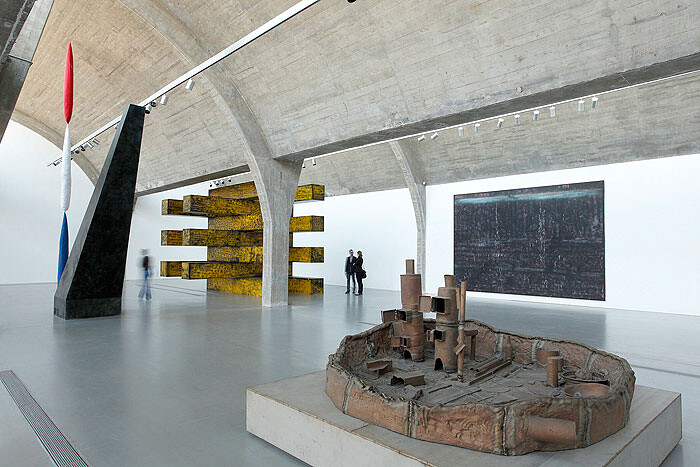Caught in that dark crawlspace between the living and the dead, hounded by a destructive, unending hunger and burdened with the need to indoctrinate: this is today’s American empire as it appears in “Vampire,” Sterling Ruby’s exhibition of new and recent work at The Pace Gallery, Beijing. Ruby has always needed to tag and topple monuments dedicated to the old order. For his 2008 exhibition SUPERMAX at the Geffen Contemporary, MOCA, Los Angeles, Ruby scratched, scarred, and defiled Minimalist-derived sculptural forms until they confessed their sins, creating a claustrophobic installation that forged links between 1960s American Minimalism and incarceration. For his first solo show in China, Ruby returns to the period’s obdurate, block-headed muteness, finding an unspoken desire for power in the geometric, reductive, and “objective” approaches made famous by Minimalists and the critics that championed them. Here Ruby reinterprets these forms, along with historically contiguous modes of painting and sculpture, dragging the whole lot squarely into a present marked by desperate consumption, global war, and economic collapse.
Ruby has a flair for the theatrical. With its star-spangled smile and dripping fangs, the soft sculpture Double Vampire 6 (unless otherwise stated, all works 2011) evokes the Rolling Stones’s lascivious tongue-and-lips logo, high on meth and out for blood. It’s plagued by a grimacing hunger without conscience, sitting in a gridlocked SUV, gobbling Oldenburg’s burgers after a visit to art history’s drive-thru. Though undead, it must continue to feast: gluttony has become its eternal curse. The only word it knows is “more.”
America’s endless conflicts in the Middle East are palpable here. An inclined, rectilinear form made of spray-painted aluminum, Predator Monolith rises from the floor as if it’s about to take flight. The work simultaneously suggests the monolith from 2001: A Space Odyssey and the wing or cockpit of a “hunter-killer” MQ-1 Predator, those unmanned aerial vehicles used by the US Air Force and CIA for classified bombings in Iraq, Afghanistan, Pakistan…wherever the war on terror takes us. A related work, Consolidator (2010-2011), repossessed from Ruby’s junkyard of spray-painted geometries, is a Euclidian take on an all-in-one cannon-cum-coffin. Predator Monolith appears to be aimed at Monument Stalagmite / Vampire Empire. The work is a monument to erectile dysfunction: a sinewy, psychedelic tower of shiny red and blue supported by an unpainted board (a “crutch,” in Ruby-speak) on which is written, in prison-jumpsuit orange, the phrase “VAMPIRE EMPIRE.”
Surrounding these works are three large bronze Debt Basins: sutured, roughly circular structures containing what look like artifacts unearthed from the site of a post-credit crisis Pompeii. Each of these reliquaries contains petrified dioramas—miniature landscapes of scavenged junk where stacked kilns become towering crematoria. Though they seem to have been sent from the tombs of an ancient, ruined culture in order to warn us, they arrive too late, foretelling a future that has already been set into motion. A series of three works called JIGS are solemnly arranged in an adjacent room: abstracted American flags made of rebar and displayed atop configurations of what looks like scrap metal—an improvised, solemn tribute to fading glory.
With their overlapping bands, scribbles and blasts of hazy, electric color, Ruby’s enormous, spray-painted canvases play at transcendence through an irreverent, day-glo nod to Rothko’s color fields. They also give a shout-out to artists such as Jane Kaufman and Jules Olitski, who continued to expand the medium of painting during the mid-60s, despite the limitations touted by Minimalism’s critical cabal. The distinction in these works is not between figure and ground, but between a series of competing planes of atmospheric color that alternately float against the painting’s surface and then recede like so many after-images. Their fuming magnetic fields draw viewers toward an imploding horizon. If the paintings sometimes suggest the luscious sunsets of Los Angeles, it’s the LA of Synanon and the Crips, seen in hindsight through the rear view mirror of an apocalyptic present.
Sterling Ruby is at the forefront of a generation of LA artists whose training enables them to successfully mine the legacy of recent sculpture, particularly Minimalism and its aftereffects—artists as different as Jason Meadows, Taft Green, Won Ju Lim, and Rachel Lachowicz. Ruby is also a storyteller, motivated by formal and ethical questions. It doesn’t matter whether Beijing audiences can identify the art historical references in Ruby’s work. His point is not to stage a solipsistic conversation about the art of the 60s, but to use his knowledge of these forms to speak to something far more pressing—the vampiric impulses of an undead empire, one that continues to devour resources because it cannot be laid to rest. To present this work in Beijing, the political heart of an economically ascendant country widely prophesized to be the next global superpower, couldn’t be more fitting.






